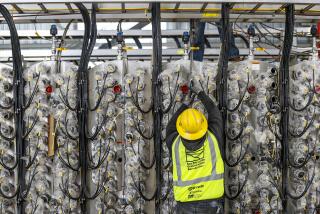Officials Use Carrot, Stick in Appeal to Potential Water Polluters
Government officials used appeals to altruism and implied threats to urge San Fernando Valley businesses Wednesday to avoid further pollution of the Valley ground-water basin, a key source of drinking water for the cities of Los Angeles, Burbank, Glendale and San Fernando.
Addressing a seminar in Van Nuys on proper disposal of hazardous waste, Los Angeles City Councilwoman Joy Picus asked 175 small-business operators to help protect “a very precious and a very vital resource” and told them: “You’ve already taken the first step just by being here.”
A prosecutor later sought to appeal to a different set of instincts. Jan Chatten-Brown, the Los Angeles County district attorney’s special assistant for occupational safety and environmental protection, urged businessmen to cooperate with environmental inspectors “when they appear at your door because I can assure you, you would much rather be dealing with them than with us.”
The free seminar, organized by the nonprofit California Safety Council, attracted operators of machine shops, metal finishing companies, auto repair shops and other small generators of hazardous waste. Council officials said there was not enough room for all the businesses that had asked to participate and that the program probably would be repeated.
Participants eventually broke into groups to get specific advice from regulatory and industry experts on proper waste management.
The event was spurred by concern about chemical contamination of Valley ground water, which provides about 15% of the Los Angeles water supply and varying amounts to Glendale and Burbank.
More than 20 wells have been closed because of contamination, principally by trichloroethylene (TCE) and perchloroethylene (PCE)--both used in metal degreasing and dry cleaning and thought to slightly raise the cancer risk for people exposed over long periods.
Four well fields in the North Hollywood-Burbank-Glendale area have been placed on the state and federal Superfund priority lists to be cleaned up.
The chemical traces were first found in the well water about seven years ago by increasingly sophisticated detection equipment. Picus said it is likely that the contaminants were present by “the World War II period, but remained undetected.”
More to Read
Sign up for Essential California
The most important California stories and recommendations in your inbox every morning.
You may occasionally receive promotional content from the Los Angeles Times.










